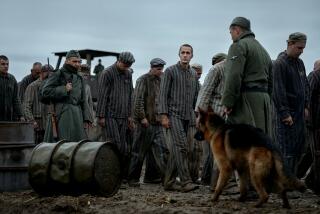World War II in One Volume : DELIVERED FROM EVIL The Saga of World War II <i> by Robert Leckie (Harper & Row: $29.95; 768 pp., with maps) </i>
- Share via
There are three ways to write about a war: from a foxhole, providing a narrow, intensely human view of a very small piece of hell; from the generals’ vision of the tactical or battlefield situation; and, most difficult of all, from a global or strategic perspective.
Any number of journalists and historians have written from one or another of these vantage points. Occasionally someone can adroitly combine two. Very rarely does a writer, popular or academic, meld the three into a coherent whole.
Still it is just that sort of comprehensive work that military historian Robert Leckie attempts in his history of World War II. To reduce the chore, he has all but eliminated or overly simplified the geopolitical factors that drove the war.
The result is a history that is distended, one that gives too much credit to field commanders like Eisenhower and too little to the staff officers like the almost forgotten Brehon Somervell, a master of military procurement, and Leslie McNair, the man who trained the 8.5 million soldiers the United States would field. Understandably, mobilization and armament are complex and not very sexy, but considering that the United States did serve as “the arsenal of democracy,” the subject surely deserves serious review in a comprehensive history.
When Leckie does turn to the geopolitical, his work seems skewed by a consuming dislike of the left. He asserts it was “leftists” who weakened the will of France to fight in 1940, ignoring the fact that collaborationist leaders like Laval were rightists in their politics while the Communists played a significant part in the Resistance. Similarly, he buys into the Yalta myth, that Stalin put one over on Churchill and Roosevelt. Any writer at this late date who thinks “the wily Koba (Stalin) cynically exploited Roosevelt’s naive trust to lower the Iron Curtain around Eastern Europe” simply has not kept up on his reading. By mid-1943 and the conference at Quebec, Roosevelt and Churchill were frankly discussing the great-power spheres of influence they knew would grow up with the end of hostilities.
There are problems too in what might be called balance. True, the 1942 battle for the island of Guadalcanal in the South Pacific was a crucial blooding of American troops, but no historian with a true world view can rate it more important than the far larger, longer and pivotal battle of Stalingrad. Still Leckie accords the island struggle no less than 90 pages and Stalingrad just 20.
There has long been a need for a judicious one-volume history of World War II. Having read some of Leckie’s earlier work, notably his autobiography “Helmet for a Pillow,” I wanted to be persuaded by the sheer beauty of the writing and convinced by the wisdom of the author’s judgments that this was that book.
Unfortunately, it is not.
Perhaps Leckie chose an impossible task. Like the war itself, the bibliography of World War II books is too large, one suspects, to be distilled into a single volume. Especially when the author cannot put aside the nationalistic prejudices that war fostered.
More to Read
Sign up for our Book Club newsletter
Get the latest news, events and more from the Los Angeles Times Book Club, and help us get L.A. reading and talking.
You may occasionally receive promotional content from the Los Angeles Times.










